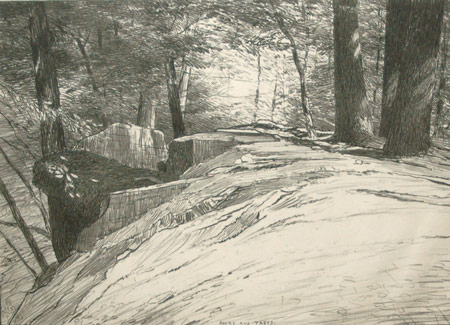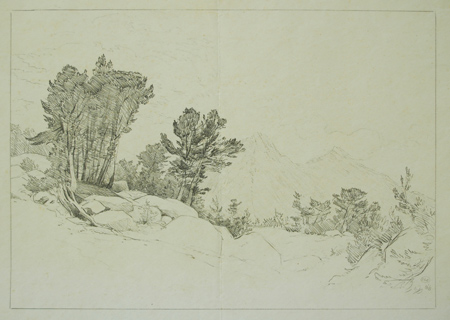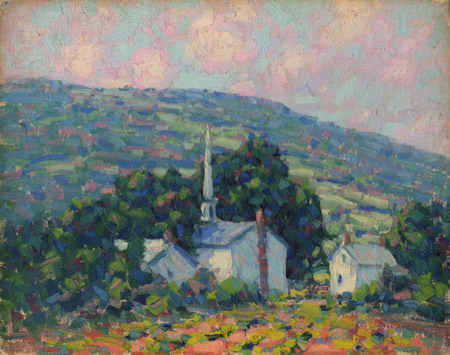
| Rocks and Trees |
lithograph |
|
| SOLD |
|
|
|
| Bolton Coit Brown (1834-1936) was an American painter, lithographer, and mountaineer. He was one of the original founders of the Byrdcliffe Colony in Woodstock, NY, part of what is now referred to as the Woodstock Art Colony. |
| California |
etching |
4 x 7 |
| SOLD |
|
|
|
| Gerome's Saw Mill |
etching |
|
| SOLD |
|
|
|
Brown was born and raised in Dresden, in upstate New York. After receiving his Masters in Painting from Syracuse University, he moved to California in 1891 to create the Art Department at Stanford University. Brown headed the department for almost ten years, but was dismissed in a dispute over his use of nude models in the classroom.
Brown was an accomplished mountain climber and benefited from Stanford’s proximity to the Sierra Nevada range, most famously explored by Sierra Club founder John Muir. Brown was the first to record climbing a group of peaks in the Sierras with, in two instances, his intrepid wife Lucy; his most challenging first ascent was of Mount Clarence King in August 1896. According to the Climber’s Guide to the High Sierra, Brown’s ascent of Mount King was the first time advanced aid-climbing techniques were used in North America. Nearby Mount Bolton Brown (13,538 ft) is named after him; Brown also named several peaks in the area of Mount King. |
 |
 |
| Mt. Brewer |
lithograph |
|
| SOLD |
|
|
|
|
| The High Sierra |
lithograph |
|
| SOLD |
|
|
|
| Brown’s skills as an artist and outdoorsman brought him to the attention of Ralph Radcliffe Whitehead (1854–1929), an aristocratic utopian who developed the concept, and supplied the capital, for the Byrdcliffe Colony. Byrdcliffe was an artists’ colony based on ideals and models provided by John Ruskin (1819–1900) and the English Arts and Crafts movement. Brown convinced Whitehead that Woodstock, NY, in the heart of the Catskill Mountains, was where Byrdcliffe should be, although Whitehead had planned on a location further south. Along with fellow artistic spirit Hervey White, also hired by Whitehead, Brown developed and managed the grounds of Byrdcliffe from 1902–1903. But Brown and White were both, ultimately, unable to sustain working relationships with Whitehead. White left of his own accord; Brown, meanwhile, was fired. |
| The Flats |
lithograph |
|
| SOLD |
|
|
|
|
| Lime Burning |
lithograph |
|
| SOLD |
|
|
|
| Landscape |
lithograph |
|
| SOLD |
|
|
|
|
| Sugar Maple |
lithograph |
|
| SOLD |
|
|
|
| Tug Hollow |
lithograph |
|
| SOLD |
|
|
|
|
| Sol Russell's Hickories |
lithograph |
|
| SOLD |
|
|
|
| Bolton Brown went on to create experimental landscape paintings, migrating between Woodstock and New York City and working within the style that came to be known as Tonalism. He exhibited one painting at the legendary 1913 Armory Show in New York but, despite skill and dedication, never succeeded as a painter. In 1915, he turned to lithography, a print-making technique that would ultimately occupy his time and intellect to an almost obsessive degree. Brown earned his greatest fame printing lithographs for well-known Woodstock artist George Bellows, whose premature death in 1925 was both a professional and emotional blow to Brown. In addition to printing for Bellows, Rockwell Kent, John Sloan, George William Eggers and others, Brown created over 400 lithographs of his own, with a focus on nature and female nudes; lithographs such as Moonlight Bathers (1915), Cloudy Dawn, (1916) and Sifting Shadows (1916) represent Brown's ability to translate Tonalism from painting into a print medium. |
 |
 |
| Country Road |
oil |
8 x 10 |
| NFS |
|
|
|
| Woodstock Church |
oil |
8 x 10 |
| NFS |
|
|
|
| Brown died in 1936 in Woodstock, alone and impoverished but by no means unaccomplished. Thinking and working ceaselessly until the end, he left behind an enormous output of lithographs and writings, including books and articles on painting and lithography and 12 volumes of journals documenting his experiments in print-making. |
| Woods at Night |
lithograph |
|
| NFS |
|
|
|
|